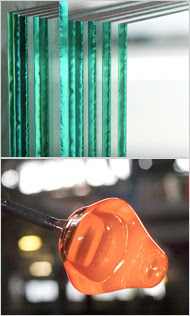>
We have often been told that old European cathedrals glazing show glass is still moving in a semi-solid state as the stained glass panels thicker at the bottom – right? Yes and no – but not for the change in the thickness of the glass.
Way back in 2008, this NY Times Science article delved into the nature of glass –
“…The (cathedral stained glass) tale contains a grain of truth about glass resembling a liquid, however. The arrangement of atoms and molecules in glass is indistinguishable from that of a liquid. But how can a liquid be as strikingly hard as glass?
“They’re the thickest and gooiest of liquids and the most disordered and structureless of rigid solids,” said Peter Harrowell, a professor of chemistry at the University of Sydney in Australia, speaking of glasses, which can be formed from different raw materials. “They sit right at this really profound sort of puzzle.”
“…scientists still disagree, with some vehemence, about the nature of glass.”
“Scientists are slowly accumulating more clues. A few years ago, experiments and computer simulations revealed something unexpected: as molten glass cools, the molecules do not slow down uniformly. Some areas jam rigid first while in other regions the molecules continue to skitter around in a liquid-like fashion. More strangely, the fast-moving regions look no different from the slow-moving ones.
Meanwhile, computer simulations have become sophisticated and large enough to provide additional insights, and yet more theories have been proffered to explain glasses.”
“The glass transition does not occur at a single, well-defined temperature; the slower the cooling, the lower the transition temperature. Even the definition of glass is arbitrary — basically a rate of flow so slow that it is too boring and time-consuming to watch. The final structure of the glass also depends on how slowly it has been cooled.”
The (very tech) article includes discussions what would happen with “cooling at an infinitely slow rate” – so not going to happen in this busy studio.
Click HERE to jump to the 2008 Kenneth Chang article in the NY Times.
Previous Glass Fun Facts postings:
Glass Fun Facts: Gaffer/Composer
More Glass Fun Facts: Bullseye Glass
Float Glass Fun Facts
Glass Fun Facts – Shattered Glass Predicts Weather